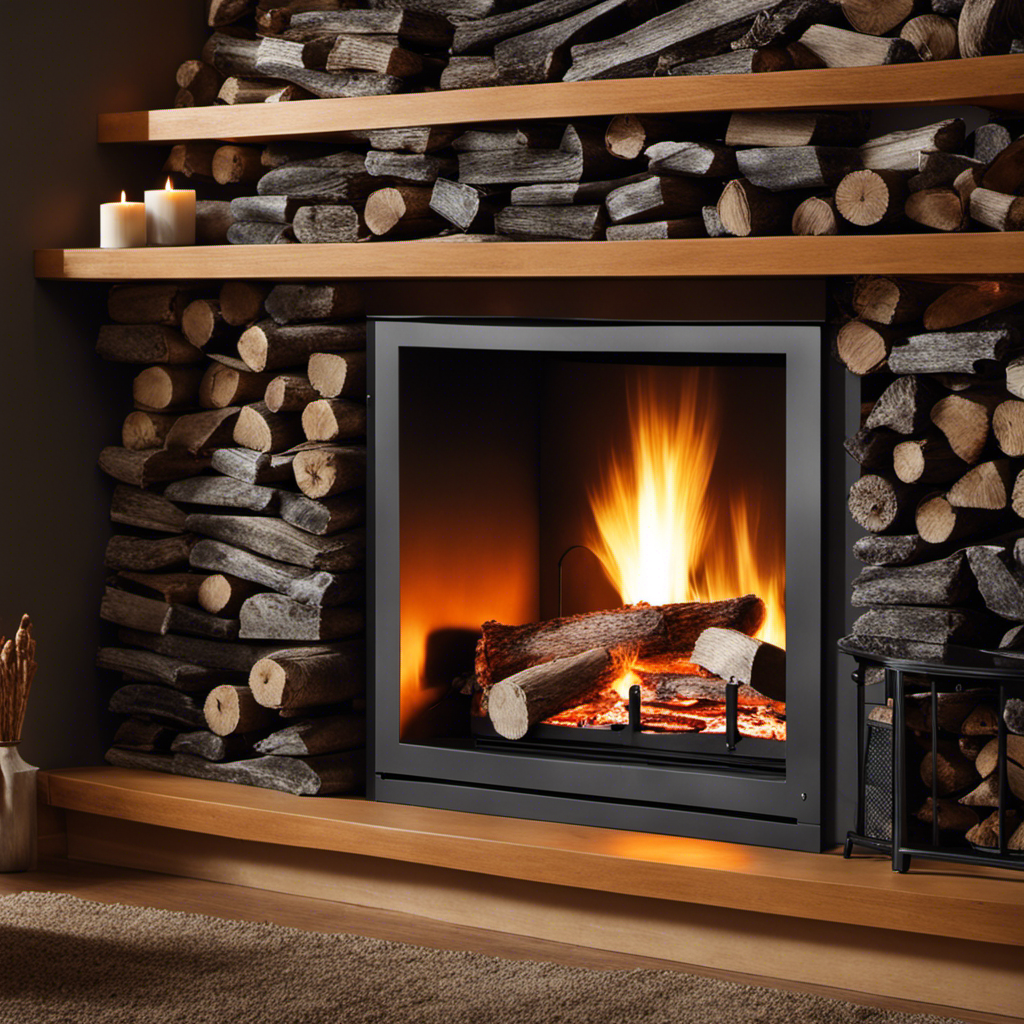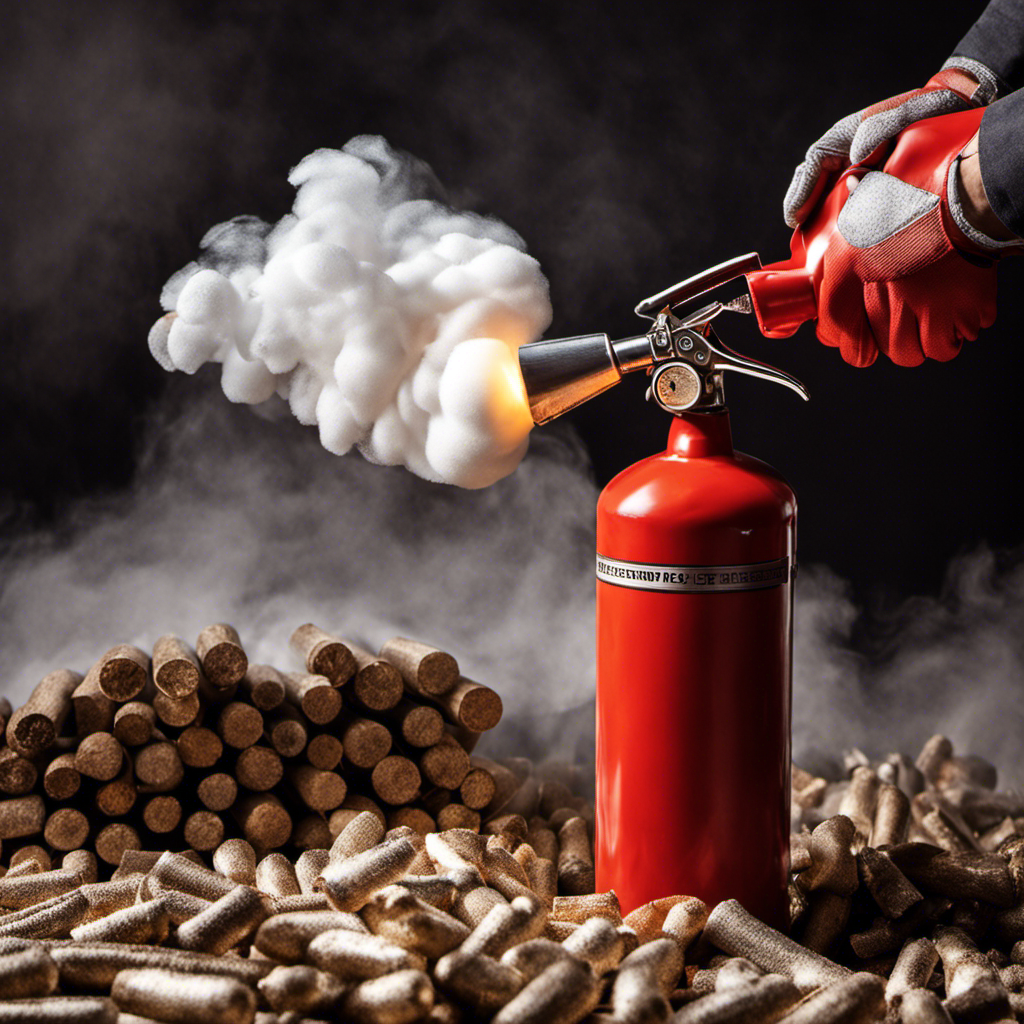Drawing on my own experiences, I want to explain how integrating a pellet stove into your wood-burning fireplace can majorly improve your heating setup, similar to outfitting it with a turbocharger.
Not only does it save you money, but it also reduces your environmental footprint.
With the convenience and efficiency it offers, you’ll wonder why you didn’t make the switch sooner.
In this article, I’ll guide you through the ins and outs of using a pellet stove in a wood burning fireplace, helping you make an informed decision.
Key Takeaways
- Pellet stoves in wood burning fireplaces offer cost effectiveness and energy efficiency.
- Pellet stoves contribute to improved air quality and reduced environmental impact.
- Pellet stoves provide convenience and ease of use compared to traditional fireplaces.
- Regular maintenance and cleaning are essential for the safe and efficient operation of pellet stoves.
The Benefits of Using a Pellet Stove in a Wood Burning Fireplace
You’ll love the benefits of using a pellet stove in your wood burning fireplace. Not only is it a cost-effective option, but it also offers exceptional energy efficiency.
Pellet stoves are designed to burn small pellets made from compressed wood or biomass materials. These pellets are readily available and affordably priced, making them a cost-effective fuel source. Additionally, pellet stoves are highly efficient in converting the fuel into heat, with efficiency ratings ranging from 70% to 90%. This means that you get more heat for less fuel, resulting in significant energy savings.
By choosing a pellet stove for your wood burning fireplace, you can enjoy the warmth and ambiance of a real fire while also benefiting from its cost effectiveness and energy efficiency.
Now let’s explore how a pellet stove can further reduce your heating expenses.
Cost Savings: How a Pellet Stove Can Reduce Heating Expenses
Installing a pellet stove can help lower heating expenses. Not only are pellet stoves efficient and cost-effective, but they also provide long-term savings. By utilizing pellets made from compressed wood or biomass materials, these stoves offer a renewable and sustainable heating solution. Let’s take a closer look at the cost savings associated with pellet stoves.
| Cost Effectiveness | Long Term Savings |
|---|---|
| Pellets are more affordable than traditional fuels such as oil or gas. | Pellet stoves have a high combustion efficiency, resulting in less wasted heat and reduced fuel consumption. |
| Pellets can be purchased in bulk, further reducing costs. | Pellet stoves require less maintenance and have a longer lifespan compared to wood-burning fireplaces. |
| Many pellet stoves are eligible for government incentives or tax credits, providing additional savings. | Pellet stoves can increase the value of your home, making them a worthwhile investment. |
In addition to the financial benefits, pellet stoves are also a greener option for heating. They produce fewer emissions and particulate matter compared to wood-burning fireplaces, contributing to improved air quality and reduced environmental impact. Transitioning into the next section, let’s explore the environmental benefits of pellet stoves and why they are a more sustainable choice.
Environmental Impact: Why Pellet Stoves Are a Greener Option
When it comes to discussing the environmental impact of pellet stoves, two key points to consider are lower carbon emissions and their use of a sustainable fuel source.
Pellet stoves are known for producing significantly fewer carbon emissions compared to traditional wood-burning stoves, making them a greener option for heating.
Additionally, the use of wood pellets, which are made from recycled wood byproducts, ensures a sustainable fuel source that reduces reliance on fossil fuels.
Lower Carbon Emissions
If you want to reduce carbon emissions, a pellet stove in your wood burning fireplace is a great option. Here’s why:
- Pellet stoves burn wood pellets, which are made from compressed sawdust and other biomass materials. These pellets are a renewable resource, unlike traditional firewood, which contributes to deforestation.
- Pellet stoves have a higher combustion efficiency compared to traditional wood burning fireplaces. This means that they generate more heat with less fuel, resulting in lower carbon emissions.
- The combustion process in pellet stoves is highly controlled, leading to fewer greenhouse gas emissions and particulate matter compared to open wood burning fireplaces.
- Pellet stoves also have the advantage of being able to be connected to a thermostat, allowing for precise temperature control and reducing energy wastage.
By incorporating a pellet stove into your wood burning fireplace, you can significantly reduce greenhouse gas emissions and contribute to sustainable heating options.
However, an important aspect of achieving this sustainability is the use of a sustainable fuel source.
Sustainable Fuel Source
Using sustainable fuel sources is essential for reducing carbon emissions and promoting a greener environment. When it comes to heating our homes, opting for sustainable heating solutions is crucial.
One such solution is using renewable energy in the form of pellet stoves. These stoves utilize pellets made from recycled wood waste, making them an eco-friendly alternative to traditional wood burning fireplaces.
By using sustainable heating, we can significantly reduce our reliance on fossil fuels, which contribute to climate change. Not only do pellet stoves help protect the environment, but they also provide efficient and effective heating for our homes.
Transitioning to sustainable fuel sources, such as pellet stoves, is a step towards simplifying your heating experience while making a positive impact on the planet.
Convenience and Ease of Use: Simplifying Your Heating Experience
Placing a pellet stove in a wood burning fireplace can greatly simplify your heating experience. Here are four reasons why this combination is a smart choice:
- Safety Precautions: When installing a pellet stove in a wood burning fireplace, it is important to follow proper safety guidelines. This includes ensuring proper ventilation, using a certified professional for installation, and regularly cleaning and maintaining the stove.
- Installation Process: While the installation process may require some modifications to the existing fireplace, it is relatively straightforward. A professional installer will ensure that the stove is properly connected to the flue and that all safety measures are in place.
- Convenient Operation: Pellet stoves are designed for easy operation. Simply load the hopper with pellets, adjust the temperature settings, and enjoy consistent warmth. No need to constantly tend to the fire or worry about sparks and embers.
- Energy Efficiency: Pellet stoves outperform traditional fireplaces in terms of efficiency. They burn wood pellets, a sustainable and renewable fuel source, which results in reduced energy consumption and lower heating costs.
Increased Efficiency: How Pellet Stoves Outperform Traditional Fireplaces
When it comes to efficiency, you’ll be pleasantly surprised by how much more efficient pellet stoves are compared to traditional fireplaces.
Pellet stoves offer increased fuel efficiency, meaning they can produce more heat with less fuel consumption. This is due to their advanced technology and design, which allows for optimal combustion and heat transfer.
Additionally, pellet stoves have a higher heat output compared to traditional fireplaces. They are specially designed to distribute heat evenly throughout the room, ensuring that every corner stays warm and cozy.
With a pellet stove, you can expect a significant improvement in heating performance, achieving optimal warmth and comfort in your home.
Now, let’s explore how these stoves can enhance your heating experience.
Heating Performance: Achieving Optimal Warmth With a Pellet Stove
In my previous discussion, I explained how pellet stoves are more efficient than traditional fireplaces. Now, let’s delve into the heating performance of a pellet stove and how it can help achieve optimal warmth in your home.
Here are four key factors that contribute to the heating performance of a pellet stove:
- Automatic Ignition: Pellet stoves have an automatic ignition feature, which means you can easily start and control the fire with the push of a button.
- Thermostat Control: With a built-in thermostat, you can set the desired temperature and let the pellet stove do the work of maintaining it, providing consistent warmth throughout your living space.
- Adjustable Heat Output: Pellet stoves offer adjustable heat settings, allowing you to customize the level of warmth based on your preference and the weather conditions.
- Efficient Heat Distribution: Pellet stoves use a fan to circulate heat, ensuring that every corner of the room receives an even distribution of warmth.
Now that we understand the heating performance of a pellet stove, let’s explore the flexibility and versatility of adapting a wood burning fireplace for pellet stove use.
Flexibility and Versatility: Adapting a Wood Burning Fireplace for Pellet Stove Use
When it comes to finding an efficient heating option for your home, a wood burning fireplace may not be the first thing that comes to mind. However, with the right adaptation, a wood burning fireplace can be transformed into a pellet stove, offering both efficient heating and an eco-friendly alternative fuel.
Efficient Heating Option
Using a pellet stove in a wood burning fireplace can be an efficient heating option for several reasons:
- Increased Efficiency: Pellet stoves are designed to burn pellets made from compressed wood or biomass, resulting in a more efficient and consistent heat output compared to traditional firewood. This means you can heat your home more effectively and evenly.
- Cost Savings: Pellet fuel is often less expensive than firewood, making it a cost-effective choice for heating your home. Additionally, pellet stoves are highly efficient, meaning you’ll use less fuel to achieve the same level of warmth, resulting in further cost savings.
- Easy Operation: Pellet stoves are equipped with automatic ignition and temperature control features, making them simple to operate. You can easily adjust the heat output to suit your comfort level without the hassle of constantly tending to a fire.
- Clean Burning: Pellet stoves produce minimal ash and emissions compared to traditional wood burning fireplaces. This not only reduces the amount of maintenance required but also makes them a more environmentally friendly heating option.
Eco-Friendly Alternative Fuel
A pellet stove is a more environmentally friendly option for heating your home compared to traditional firewood. Not only does it provide an efficient heating solution, but it also utilizes renewable energy sources. Pellet stoves burn small, compressed pellets made from recycled sawdust, wood chips, and agricultural waste. These pellets are considered a renewable energy source because they are made from sustainable materials that would otherwise go to waste. By using pellet stoves, we reduce our reliance on fossil fuels and contribute to a cleaner environment.
Here is a table highlighting the key benefits of using a pellet stove as an alternative heating option:
| Benefits of Pellet Stoves |
|---|
| Renewable Energy Source |
| Efficient and Even Heat Distribution |
| Reduced Emissions |
| Cost-effective |
| Low-maintenance |
Maintenance and Cleaning: Keeping Your Pellet Stove in Top Shape
Regular maintenance and cleaning are essential for keeping your pellet stove in top shape. Here are some maintenance tips and troubleshooting common issues that can help ensure your pellet stove operates efficiently:
- Clean the burn pot and ash pan regularly to prevent ash buildup and maintain proper combustion.
- Check and clean the exhaust vent to prevent blockages and ensure proper ventilation.
- Inspect the gaskets and seals for any wear or damage and replace them if necessary to prevent air leaks.
- Regularly clean or replace the air intake filter to maintain optimal airflow and prevent dust buildup.
By following these maintenance tips and troubleshooting common issues, you can keep your pellet stove running smoothly and efficiently.
Now, let’s move on to safety considerations: understanding the differences in fire hazards.
Safety Considerations: Understanding the Differences in Fire Hazards
Now that we’ve discussed the importance of maintenance and cleaning for your pellet stove, let’s shift our focus to safety considerations.
When it comes to fire safety, understanding the differences in fire hazards between a traditional wood burning fireplace and a pellet stove is crucial. While both can provide warmth and ambiance to your home, pellet stoves have specific maintenance requirements that help minimize fire risks.
One of the key advantages of a pellet stove is that it eliminates the need for open flames, reducing the risk of sparks and embers escaping the fireplace. Additionally, pellet stoves have automatic shut-off features and built-in safety mechanisms that can detect potential fire hazards, such as a blocked exhaust or excessive heat.
By following the manufacturer’s guidelines for maintenance and cleaning, you can ensure that your pellet stove remains in optimal condition and operates safely. Regularly inspecting and cleaning the exhaust vent, ash traps, and hopper are essential steps in preventing fire hazards.
As we move forward, let’s now explore the next consideration in this process: choosing the right pellet stove for your wood burning fireplace.
Choosing the Right Pellet Stove for Your Wood Burning Fireplace
When selecting the appropriate pellet stove for your existing fireplace, it’s important to consider factors such as size, efficiency, and installation requirements. Here are four key points to guide you in choosing the right pellet stove and maximizing energy efficiency:
- Size: Ensure that the pellet stove you choose is the appropriate size for your fireplace. Measure the dimensions of your fireplace opening and select a stove that fits snugly.
- Efficiency: Look for a pellet stove with a high efficiency rating. This will ensure that the stove burns fuel efficiently and minimizes waste.
- Installation: Consider the installation requirements of the pellet stove. Some stoves may require professional installation, while others can be easily installed by homeowners.
- Features: Research the features offered by different pellet stoves. Look for features such as programmable thermostats, remote controls, and ash removal systems to enhance convenience and functionality.
Frequently Asked Questions
What Are the Main Benefits of Using a Pellet Stove in a Wood Burning Fireplace?
The main benefits of using a pellet stove in a wood burning fireplace are its efficiency and advantages. It provides better heat output, reduces fuel consumption, and is more environmentally friendly.
How Much Money Can I Save on Heating Expenses by Using a Pellet Stove?
Installing a pellet stove can lead to significant savings on heating expenses. By calculating the cost difference between using a pellet stove and traditional heating methods, you can determine the potential amount of money you can save.
What Is the Environmental Impact of Using a Pellet Stove Compared to a Traditional Fireplace?
Using a pellet stove in a wood burning fireplace reduces the carbon footprint compared to a traditional fireplace. Pellet stoves are powered by renewable energy sources, making them an environmentally friendly heating option.
How Easy Is It to Use a Pellet Stove in a Wood Burning Fireplace?
Using a pellet stove in a wood burning fireplace is a breeze! It’s a game-changer in efficiency, heating your home with ease. Plus, converting to a pellet stove is a smart move for convenience and cost savings.
What Maintenance and Cleaning Tasks Are Required to Keep a Pellet Stove in Good Condition?
Maintenance tasks and cleaning requirements are essential to keep a pellet stove in good condition. Regularly cleaning the ash pan, inspecting the burn pot, and checking the exhaust system are crucial for optimal performance and longevity.
Conclusion
In conclusion, placing a pellet stove in a wood burning fireplace offers numerous benefits that make it a worthwhile investment. Not only can it lead to significant cost savings, but it also has a positive environmental impact by reducing carbon emissions.
Additionally, the convenience, increased efficiency, and versatility of pellet stoves make them a superior choice compared to traditional fireplaces. With proper maintenance and safety considerations, homeowners can enjoy the warmth and ambiance of a wood burning fireplace while enjoying the many advantages that a pellet stove has to offer.
According to recent studies, homes equipped with pellet stoves have seen a reduction in heating expenses by up to 40%, making it a smart and economical choice for homeowners.
Growing up surrounded by the vast beauty of nature, Sierra was always drawn to the call of the wild. While others sought the comfort of the familiar, she ventured out, embracing the unpredictable and finding stories in the heartbeat of nature.
At the epicenter of every remarkable venture lies a dynamic team—a fusion of diverse talents, visions, and passions. The essence of Best Small Wood Stoves is crafted and refined by such a trio: Sierra, Logan, and Terra. Their collective expertise has transformed the platform into a leading authority on small wood stoves, radiating warmth and knowledge in equal measure.











